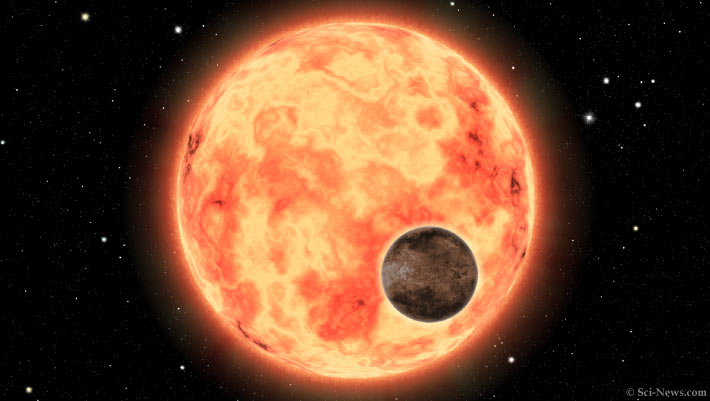Established in 2006 by the International Astronomical Union, the current definition specifies that to qualify as a planet, a celestial body must orbit the Sun within our Solar System. But this definition is problematic both because it is not quantitative and because it excludes exoplanets. The proposed new definition specifies that the body may orbit one or more stars, brown dwarfs or stellar remnants and sets mass limits that should apply to planets everywhere.
An artist’s impression of an exoplanet and its host star. Image credit: Sci.News.
In 2006, the International Astronomical Union (IAU) adopted resolution B5, which contains the following definition: a planet is a celestial body that (a) is in orbit around the Sun, (b) has sufficient mass for its self-gravity to overcome rigid body forces so that it assumes a hydrostatic equilibrium (nearly round) shape, and (c) has cleared the neighborhood around its orbit.
“The current definition specifically mentions orbiting our Sun,” said Professor Jean-Luc Margot from the University of California, Los Angeles.
“We now know about the existence of thousands of planets, but the IAU definition applies only to the ones in our Solar System.”
“We propose a new definition that can be applied to celestial bodies that orbit any star, stellar remnant or brown dwarf.”
Professor Margot and his colleagues argue that while the requirement to orbit our Sun is too specific, other criteria in the IAU definition are too vague.
For example, it says a planet has ‘cleared its orbit’ without stating what that means.
The proposed new definition contains quantifiable criteria that can be applied for defining planets inside and outside our Solar System.
In the new definition, a planet is a celestial body that (a) orbits one or more stars, brown dwarfs or stellar remnants, (b) is more massive than 1023 kg, and (c) is less massive than 13 Jupiter masses (2.5 * 1028 kg).
The authors ran a mathematical algorithm on the properties of objects in our Solar System to see which objects clustered together.
The analysis revealed groups of distinct qualities shared by planets in the Solar System that can be used as a starting point for creating a taxonomy for planets in general.
For example, if an object has enough gravity to clear a path by accumulating or ejecting smaller objects nearby, it is said to be dynamically dominant.
“All the planets in our Solar System are dynamically dominant, but other objects — including dwarf planets like Pluto and asteroids — are not. So this property can be included in the definition of planet,” Professor Margot said.
The requirement for dynamical dominance provides a lower limit on mass.
But potential planets can also be too big to fit the new definition.
Some gas giants, for example, are so large that thermonuclear fusion of deuterium occurs, and the object becomes a substar called a brown dwarf and therefore not a planet. This limit has been determined to be the mass of 13 or more Jupiters.
The current requirement to be spherical, on the other hand, is more problematic.
Distant planets can rarely be observed in enough detail to ascertain their shape with certainty.
The researchers argue that the shape requirement is so difficult to implement that it is effectively useless for definitional purposes, even though planets are generally round.
“Having definitions anchored to the most easily measurable quantity — mass — removes arguments about whether or not a specific object meets the criterion. This is a weakness of the current definition,” said Dr. Brett Gladman, a researcher at the University of British Columbia.
“The good news is that, in the Solar System, celestial bodies larger than 1021 kg appear to be round.”
“So all bodies that satisfy the proposed lower limit on mass of 1023 kg are expected to be spherical.”
The team’s paper was published in the Planetary Science Journal.
_____
Jean-Luc Margot et al. Quantitative Criteria for Defining Planets. Planet. Sci. J 5, 159; doi: 10.3847/PSJ/ad55f3



